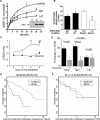Pharmacogenomics of beta-adrenergic receptors and their accessory signaling proteins in heart failure
- PMID: 20443857
- PMCID: PMC5350665
- DOI: 10.1111/j.1752-8062.2008.00059.x
Pharmacogenomics of beta-adrenergic receptors and their accessory signaling proteins in heart failure
Abstract
beta-Adrenergic receptors (betaAR) are widely expressed on cardiovascular cells. Pharmacological stimulation or blockade of betaAR signaling is the therapeutic mainstay in cardiogenic shock, hypertension, ischemia, arrhythmias, and heart failure. Interindividual variability in the response to betaAR agonists and antagonists has prompted examination of variability in the genes encoding betaAR signaling pathway members. Prominent among the genes that have been examined so far in heart failure are the beta(1)AR, beta(2)AR, and G-protein-coupled receptor kinase 5 (GRK5). Each has nonsynonymous polymorphisms that alter amino acid sequence and protein function and regulation in cell-based systems, genetically altered mouse models, or human hearts. Here, we review these phenotypes and results from published clinical studies, with a focus on heart failure pharmacogenomics. Thus far, very few studies have utilized analogous protocols or drugs, and discrepancies in the clinical studies are apparent. A compelling approach is the use of multiple methods to understand the molecular, cellular, and organ phenotypes of a variant and couple these with clinical studies designed to specifically address the relevance of those phenotypes in humans. Undoubtedly, additional loci will be identified, and together, will provide for genetically driven, individualized treatments for heart failure.
Figures





Similar articles
-
A GRK5 polymorphism that inhibits beta-adrenergic receptor signaling is protective in heart failure.Nat Med. 2008 May;14(5):510-7. doi: 10.1038/nm1750. Epub 2008 Apr 20. Nat Med. 2008. PMID: 18425130 Free PMC article.
-
Pharmacogenetics of beta-1- and beta-2-adrenergic receptors.Pharmacology. 2000 Sep;61(3):167-73. doi: 10.1159/000028397. Pharmacology. 2000. PMID: 10971202 Review.
-
Beta-blocker pharmacogenetics in heart failure.Heart Fail Rev. 2010 May;15(3):187-96. doi: 10.1007/s10741-008-9094-x. Epub 2008 Apr 24. Heart Fail Rev. 2010. PMID: 18437562 Free PMC article. Review.
-
The emerging pharmacogenomics of the beta-adrenergic receptors.Congest Heart Fail. 2004 Nov-Dec;10(6):281-8. doi: 10.1111/j.1527-5299.2004.02019.x. Congest Heart Fail. 2004. PMID: 15591842 Review.
-
β-adrenergic receptor polymorphisms in susceptibility, response to treatment and prognosis in heart failure: implication of ethnicity.Mol Med Rep. 2013 Jan;7(1):259-65. doi: 10.3892/mmr.2012.1120. Epub 2012 Oct 9. Mol Med Rep. 2013. PMID: 23064657
Cited by
-
The genetics of cardiac failure: Role of a G protein-coupled receptor polymorphism in therapeutic response in an Indian population.J Clin Transl Res. 2021 Jul 30;7(4):501-510. eCollection 2021 Aug 26. J Clin Transl Res. 2021. PMID: 34541364 Free PMC article.
-
Nuclear effects of G-protein receptor kinase 5 on histone deacetylase 5-regulated gene transcription in heart failure.Circ Heart Fail. 2011 Sep;4(5):659-68. doi: 10.1161/CIRCHEARTFAILURE.111.962563. Epub 2011 Jul 18. Circ Heart Fail. 2011. PMID: 21768220 Free PMC article.
-
Clinical and genetic modifiers of long-term survival in heart failure.J Am Coll Cardiol. 2009 Jul 28;54(5):432-44. doi: 10.1016/j.jacc.2009.05.009. J Am Coll Cardiol. 2009. PMID: 19628119 Free PMC article.
-
Mapping genetic contributions to cardiac pathology induced by Beta-adrenergic stimulation in mice.Circ Cardiovasc Genet. 2015 Feb;8(1):40-9. doi: 10.1161/CIRCGENETICS.113.000732. Epub 2014 Dec 5. Circ Cardiovasc Genet. 2015. PMID: 25480693 Free PMC article.
-
β1-adrenergic receptor O-glycosylation regulates N-terminal cleavage and signaling responses in cardiomyocytes.Sci Rep. 2017 Aug 11;7(1):7890. doi: 10.1038/s41598-017-06607-z. Sci Rep. 2017. PMID: 28801655 Free PMC article.
References
-
- Lefkowitz RJ. Seven transmembrane receptors: something old, something new. Acta Physiol. 2007; 190: 9–19. - PubMed
-
- Bristow MR. Beta‐adrenergic receptor blockade in chronic heart failure. Circ. 2000; 101: 558–569. - PubMed
-
- Bristow MR. Mechanistic and clinical rationales for using beta‐blockers in heart failure. J Card Fail. 2000; 6: 8–14. - PubMed
-
- Mason DA, Moore JD, Green SA, Liggett SB. A gain‐of‐function polymorphism in a G‐protein coupling domain of the human β1‐adrenergic receptor. J Biol Chem. 1999; 274: 12670–12674. - PubMed
Publication types
MeSH terms
Substances
Grants and funding
LinkOut - more resources
Full Text Sources
Medical
Research Materials

